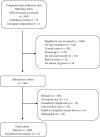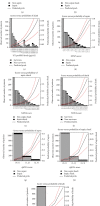Combination of Prehospital NT-proBNP with qSOFA and NEWS to Predict Sepsis and Sepsis-Related Mortality
- PMID: 35242244
- PMCID: PMC8886755
- DOI: 10.1155/2022/5351137
Combination of Prehospital NT-proBNP with qSOFA and NEWS to Predict Sepsis and Sepsis-Related Mortality
Abstract
Background: The aim of this study was to assess the role of prehospital point-of-care N-terminal probrain natriuretic peptide to predict sepsis, septic shock, or in-hospital sepsis-related mortality.
Methods: A prospective, emergency medical service-delivered, prognostic, cohort study of adults evacuated by ambulance and admitted to emergency department between January 2020 and May 2021. The discriminative power of the predictive variable was assessed through a prediction model trained using the derivation cohort and evaluated by the area under the curve of the receiver operating characteristic on the validation cohort.
Results: A total of 1,360 patients were enrolled with medical disease in the study. The occurrence of sepsis, septic shock, and in-hospital sepsis-related mortality was 6.4% (67 cases), 4.2% (44 cases), and 6.1% (64 cases). Prehospital National Early Warning Score 2 had superior predictive validity than quick Sequential Organ Failure Assessment and N-terminal probrain natriuretic peptide for detecting sepsis and septic shock, but N-terminal probrain natriuretic peptide outperformed both scores in in-hospital sepsis-related mortality estimation. Application of N-terminal probrain natriuretic peptide to subgroups of the other two scores improved the identification of sepsis, septic shock, and sepsis-related mortality in the group of patients with low-risk scoring.
Conclusions: The incorporation of N-terminal probrain natriuretic peptide in prehospital care combined with already existing scores could improve the identification of sepsis, septic shock, and sepsis-related mortality.
Copyright © 2022 Francisco Martín-Rodríguez et al.
Conflict of interest statement
The authors declare that they have no conflicts of interest.
Figures


Similar articles
-
Predictive value of N-terminal pro-brain natriuretic peptide in severe sepsis and septic shock.Crit Care Med. 2007 May;35(5):1277-83. doi: 10.1097/01.CCM.0000261893.72811.0F. Crit Care Med. 2007. PMID: 17414731
-
The N-terminal pro brain natriuretic peptide is the best predictor of mortality during hospitalization in patients with low risk of sepsis-related organ failure.Med Clin (Barc). 2017 Sep 8;149(5):189-195. doi: 10.1016/j.medcli.2017.02.036. Epub 2017 May 2. Med Clin (Barc). 2017. PMID: 28473224 English, Spanish.
-
N-terminal pro-brain natriuretic peptide and cardiac troponin I for the prognostic utility in elderly patients with severe sepsis or septic shock in intensive care unit: A retrospective study.J Crit Care. 2015 Jun;30(3):654.e9-14. doi: 10.1016/j.jcrc.2014.12.008. Epub 2014 Dec 18. J Crit Care. 2015. PMID: 25575850
-
Comparison of qSOFA and Hospital Early Warning Scores for prognosis in suspected sepsis in emergency department patients: a systematic review.Emerg Med J. 2022 Apr;39(4):284-294. doi: 10.1136/emermed-2020-210416. Epub 2021 Aug 17. Emerg Med J. 2022. PMID: 34404680
-
Early Recognition of Sepsis in Prehospital Settings: A Review of Screening Tools and Practices.Adv Emerg Nurs J. 2025 Apr-Jun 01;47(2):152-167. doi: 10.1097/TME.0000000000000561. Epub 2025 Apr 1. Adv Emerg Nurs J. 2025. PMID: 40168615 Review.
Cited by
-
The value of NT-proBNP, NLR, Ang-1 combined with APACHE II and SOFA scores in evaluating 28-day mortality of septic shock.Medicine (Baltimore). 2025 Jun 6;104(23):e42547. doi: 10.1097/MD.0000000000042547. Medicine (Baltimore). 2025. PMID: 40489844 Free PMC article.
-
Prediction of 28-day mortality in patients with sepsis based on a predictive model: A retrospective cohort study.J Int Med Res. 2025 Aug;53(8):3000605251361104. doi: 10.1177/03000605251361104. Epub 2025 Jul 31. J Int Med Res. 2025. PMID: 40744906 Free PMC article.
-
NEWS, SIRS and qSOFA criteria for predicting sepsis and sepsis with high risk of death in emergency room: A comparison study and improved predictive models based on local data from CETAT and MIMIC-IV databases.Biomol Biomed. 2025 May 8;25(7):1470-1478. doi: 10.17305/bb.2024.11134. Biomol Biomed. 2025. PMID: 39508793 Free PMC article.
-
Development of a Nomogram for Predicting Mortality Risk in Sepsis Patients During Hospitalization: A Retrospective Study.Infect Drug Resist. 2023 Apr 19;16:2311-2320. doi: 10.2147/IDR.S407202. eCollection 2023. Infect Drug Resist. 2023. PMID: 37155474 Free PMC article.
-
Sepsis Biomarkers: Advancements and Clinical Applications-A Narrative Review.Int J Mol Sci. 2024 Aug 19;25(16):9010. doi: 10.3390/ijms25169010. Int J Mol Sci. 2024. PMID: 39201697 Free PMC article. Review.
References
Publication types
MeSH terms
Substances
LinkOut - more resources
Full Text Sources
Medical
Research Materials

